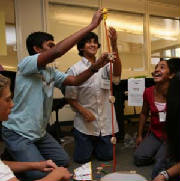|
William Huitt, a professor at Valdosta State University, developed methods that teachers can use to teach values to their
students. Below is a table that shows different Value Education ideas and methods that can be used
Overview of Typology of Values Education
Approaches
|
|
|
|
|
|
- To instill or internalize certain values in students;
- To change the values of students so they more nearly reflect certain desired values
|
- Modeling;
- Positive and negative reinforcement;
- Manipulating alternatives;
- Games and simulations;
- Role playing
|
|
|
- To help students develop more complex
moral reasoning patterns based on a higher set of values;
- To urge students to discuss
the reasons for their value choices and positions, not merely to share with others, but to foster change in the stages of
reasoning of students
|
- Moral dilemma episodes with small-group
discussion;
- Relatively structured and
argumentative without necessarily coming to a "right" answer
|
|
Analysis
|
- To help students use logical thinking
and scientific investigation to decide value issues and questions
- To help students use rational,
analytical processes in interrelating and conceptualizing their values
|
- Structured rational discussion that
demands application of reasons as well as evidence;
- Testing principles;
- Analyzing analogous cases;
- Research and debate
|
|
Values Clarification
|
- To help students become aware of
and identify their own values and those of others;
- To help students communicate openly
and honestly with others about their values;
- To help students use both
rational thinking and emotional awareness to examine their personal feelings, values, and behavior patterns
|
- Role-playing games;
- Simulations;
- Contrived or real value-laden situations;
- In-depth self-analysis exercises;
- Sensitivity activities;
- Out-of-class activities;
- Small group discussions
|
|
Action Learning
|
- Those purposes listed for analysis
and values clarification;
- To provide students with opportunities
for personal and social action based on their values;
- To encourage students to
view themselves as personal-social interactive beings, not fully autonomous, but members of a community or social system
|
- Methods listed for analysis and
values clarification;
- Projects within school and community
practice;
- Skill practice in group
organizing and interpersonal relations
|
Character Education
Character
education is a direct approach in teaching students moral and immoral behavior. Teachers are to teach students that
stealing, cheating, hurting others, etc. is wrong. If a student breaks these rules, they are to be punished. Students
are rewarded for proper behavior.
Strategies
that can be used
- role-playing
- peer-centered discussion and
reflection
- rewarding for good behavior
- peer tutoring
Other strategies
- Focus moral education around the "common
ground" or moral core (Nucci's moral rules)
- Have small-group discussions and then
whole-group discussions to get all students involved
- Should not be textbook oriented
- Some element of controversy
- Incorporate moral learning into the
curriculum directly, and not hidden

|

